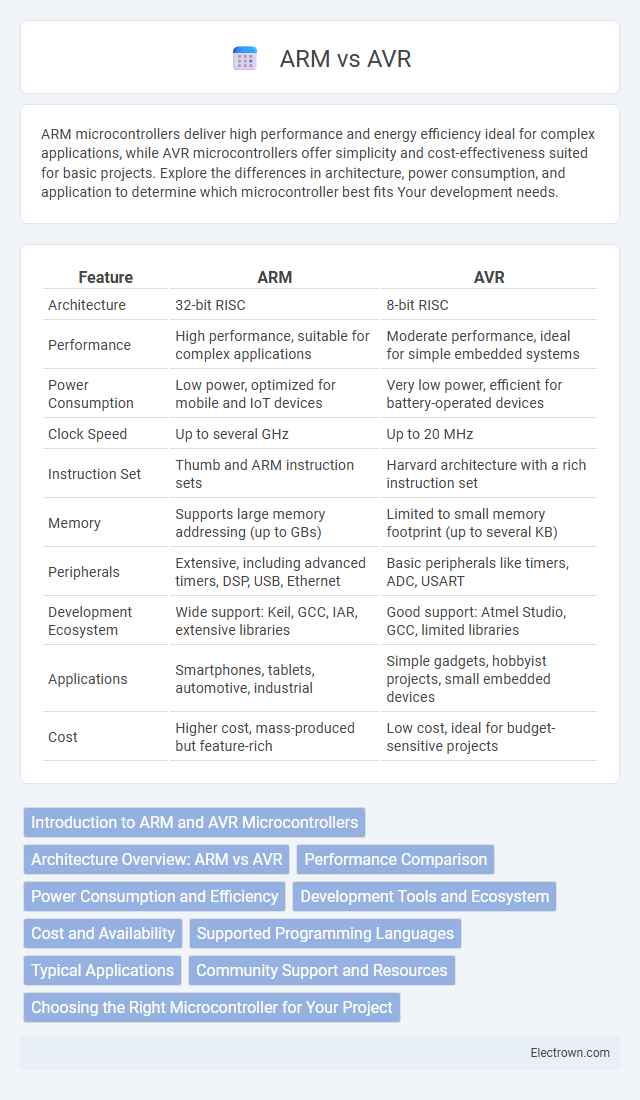ARM microcontrollers deliver high performance and energy efficiency ideal for complex applications, while AVR microcontrollers offer simplicity and cost-effectiveness suited for basic projects. Explore the differences in architecture, power consumption, and application to determine which microcontroller best fits Your development needs.
Table of Comparison
| Feature | ARM | AVR |
|---|---|---|
| Architecture | 32-bit RISC | 8-bit RISC |
| Performance | High performance, suitable for complex applications | Moderate performance, ideal for simple embedded systems |
| Power Consumption | Low power, optimized for mobile and IoT devices | Very low power, efficient for battery-operated devices |
| Clock Speed | Up to several GHz | Up to 20 MHz |
| Instruction Set | Thumb and ARM instruction sets | Harvard architecture with a rich instruction set |
| Memory | Supports large memory addressing (up to GBs) | Limited to small memory footprint (up to several KB) |
| Peripherals | Extensive, including advanced timers, DSP, USB, Ethernet | Basic peripherals like timers, ADC, USART |
| Development Ecosystem | Wide support: Keil, GCC, IAR, extensive libraries | Good support: Atmel Studio, GCC, limited libraries |
| Applications | Smartphones, tablets, automotive, industrial | Simple gadgets, hobbyist projects, small embedded devices |
| Cost | Higher cost, mass-produced but feature-rich | Low cost, ideal for budget-sensitive projects |
Introduction to ARM and AVR Microcontrollers
ARM microcontrollers feature a 32-bit architecture known for high performance, energy efficiency, and widespread use in smartphones, embedded systems, and IoT devices. AVR microcontrollers are an 8-bit family designed by Atmel, prized for simplicity, low power consumption, and ease of programming in hobbyist and small-scale applications. Your choice between ARM and AVR depends on project requirements, balancing processing power and resource constraints.
Architecture Overview: ARM vs AVR
ARM architecture features a 32-bit RISC design with a complex instruction set optimized for high performance and power efficiency, widely used in smartphones, tablets, and embedded systems. AVR architecture is an 8-bit RISC microcontroller known for simplicity, low power consumption, and ease of programming, commonly found in hobbyist electronics and small embedded applications. ARM cores offer higher clock speeds, advanced pipeline stages, and extensive peripheral integration compared to the simpler, single-cycle execution and Harvard architecture of AVR microcontrollers.
Performance Comparison
ARM processors deliver significantly higher performance than AVR microcontrollers, featuring advanced 32-bit architecture, faster clock speeds, and superior processing power ideal for complex and demanding applications. AVR microcontrollers, typically 8-bit or 16-bit, offer lower performance but excel in simplicity and energy efficiency for basic control tasks. Your choice depends on the performance requirements of your project, with ARM suitable for high-speed computation and multitasking, while AVR is optimal for low-power, cost-sensitive applications.
Power Consumption and Efficiency
ARM microcontrollers typically offer superior power consumption management due to advanced sleep modes and dynamic voltage scaling, making them highly efficient for battery-powered applications. In contrast, AVR microcontrollers consume more power under similar conditions but excel in simpler, low-power tasks with less complexity in hardware. Your choice depends on the required balance between processing power and energy efficiency for your specific project.
Development Tools and Ecosystem
ARM microcontrollers benefit from a vast ecosystem featuring powerful development tools like Keil MDK, ARM GCC, and STM32CubeIDE that support a wide range of applications from consumer electronics to industrial systems. AVR microcontrollers leverage the Atmel Studio and AVR GCC toolchain, offering simplicity and ease of use for beginners and hobbyists in embedded development. Both platforms have active community support and extensive libraries, but ARM's ecosystem provides broader scalability and advanced debugging capabilities for complex projects.
Cost and Availability
ARM microcontrollers generally offer a wider range of price points, making them cost-effective options for mass production due to economies of scale and broad manufacturer support. AVR chips tend to have a lower upfront cost and are readily available for hobbyists and small-scale projects, supported by a strong community and extensive documentation. Your choice between ARM and AVR will depend on budget constraints and the availability of components suited to your specific application needs.
Supported Programming Languages
ARM microcontrollers support a wide range of programming languages including C, C++, assembly, and increasingly higher-level languages like Python through specialized interpreters. AVR microcontrollers primarily rely on C and assembly for programming, with less flexibility in supporting newer or higher-level languages. Choosing ARM gives you access to a broader ecosystem and modern development tools that enhance programming language options.
Typical Applications
ARM microcontrollers dominate in applications requiring high processing power and energy efficiency, such as smartphones, automotive systems, and industrial automation. AVR microcontrollers excel in simpler, cost-sensitive tasks like consumer electronics, small appliances, and hobbyist projects due to their ease of use and low power consumption. Your choice depends on whether you prioritize advanced features or straightforward, reliable performance for embedded systems.
Community Support and Resources
ARM microcontrollers benefit from a vast global community and extensive resources due to their widespread use in diverse industries, offering abundant libraries, development tools, and forums. AVR microcontrollers maintain strong support within the hobbyist and educational sectors, with numerous tutorials, open-source projects, and dedicated user groups facilitating learning and project development. Both platforms enjoy active communities, but ARM's broader adoption typically results in richer resources for professional and complex applications.
Choosing the Right Microcontroller for Your Project
ARM microcontrollers offer higher processing power, extensive peripheral support, and energy-efficient capabilities ideal for complex, performance-driven applications. AVR microcontrollers provide simplicity, ease of use, and cost-effectiveness, making them suitable for beginner projects and less demanding tasks. Evaluating your project's requirements for speed, power consumption, development complexity, and budget will help you determine the most appropriate microcontroller family.
ARM vs AVR Infographic

 electrown.com
electrown.com